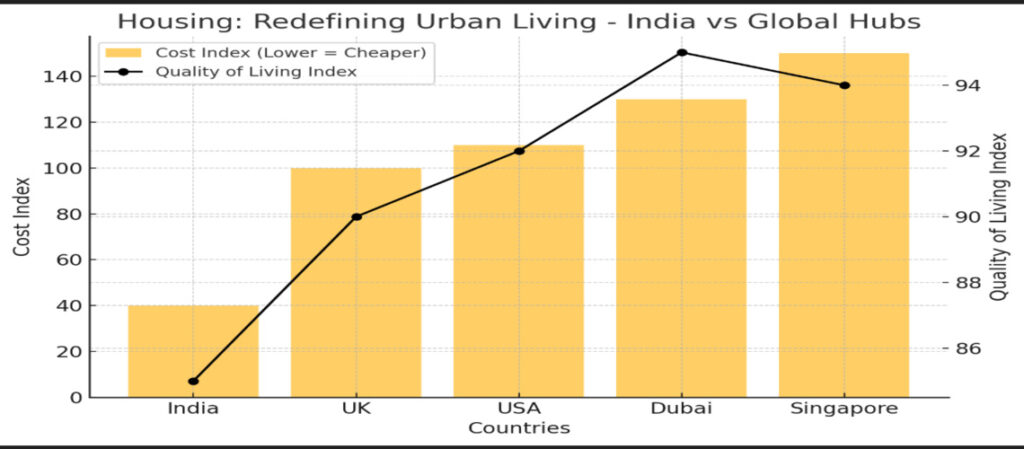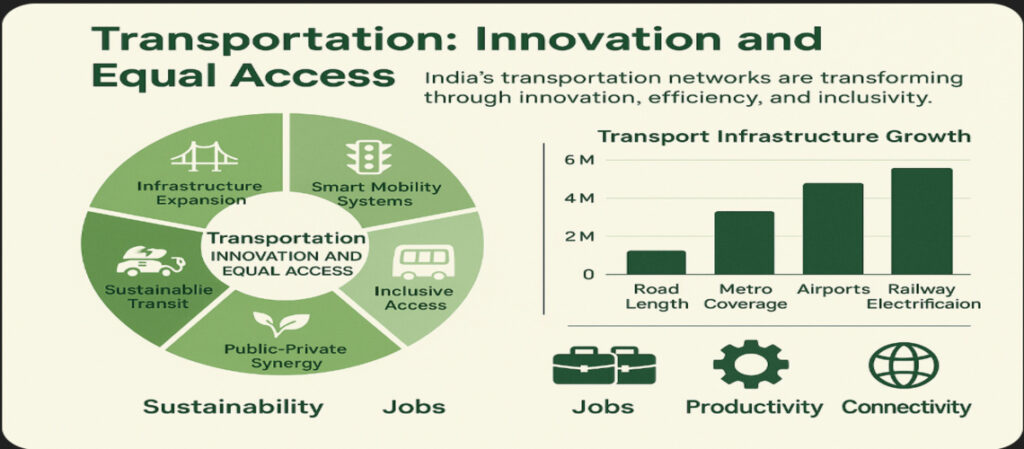Introduction
In today’s interconnected world, measuring prosperity is about more than just economic statistics — it is about the true quality of life a country can provide for its citizens. The Cost of Living Index, or Consumer Price Index (CPI), is a mirror reflecting not only economic strength but also the day-to-day reality of households. A recent comparative study examining India, the UK, USA, Singapore, and Dubai reveals a compelling narrative: India stands out as a model for smart living, balanced growth, and value-driven progress.
CPI at a Glance: Stability in a Volatile World
While much of the world continues to grapple with inflation and market volatility, India’s year-on-year inflation rate, based on the Consumer Price Index (CPI), eased to 1.55% in July 2025, the lowest level in eight years. This moderation highlights the country’s economic stability and effective price management.
In contrast, advanced economies such as the United States and the United Kingdom continue to experience significantly higher cost pressures, as reflected in their CPI readings (U.S.: 324.8; U.K.: 139.3). These figures underline the rising cost of essentials in those markets.
India’s resilient economic framework ensures essential goods remain within reach, strengthening consumer confidence and sustaining domestic stability. This balance exemplifies India’s commitment to sustainable growth without compromising accessibility.
Below is the country-wise CPI inflation data.

Digital Connectivity: Powering an Inclusive Future
India has emerged as a global leader in accessible internet connectivity, enabled by sustained investment in advanced digital infrastructure. The country now leads the world in digital value, with 1GB of mobile data priced significantly lower than in the USA, UK, Singapore, or Dubai.
This digital transformation has enabled diverse participation in e-governance, remote education, and entrepreneurship. As a result, India’s digital economy is among the most inclusive in the world, driving social and economic empowerment across urban and rural communities alike.

Housing: Redefining Urban Living
India’s metropolitan centres are at the forefront of redefining modern urban living. The country’s efficient and scalable design of housing, utilities, and daily services allows families and individuals to enjoy vibrant city life at a fraction of the cost found in other global hubs.
This approach empowers both local residents and international professionals, making Indian cities attractive destinations for those seeking quality living standards without disproportionate expenses. Compared to the UK, USA, Dubai, and Singapore, India’s urban environments offer exceptional value and comfort.

Everyday Essentials: Strength in Sustainability
India’s supply chain and agricultural advancements guarantee the consistent availability of fresh vegetables, dairy, grains, and other household necessities. Strong domestic production buffers the country from global price shocks and maintains stable consumer prices.
This reliability not only supports robust food security but also enhances India’s export potential, demonstrating the nation’s ability to sustain its growing population while contributing to the global marketplace.

Transportation: Innovation and Equal Access
India’s transportation systems, whether they are commercial or public, are changing with an eye toward innovation and inclusivity.
From the Vande Bharat Express, India’s first indigenous semi high speed train, to expanding metro networks in over 15 cities and emerging hyperloop feasibility studies, India’s transport infrastructure is transitioning into a globally benchmarked system.
The efficiency of everyday transportation, strengthened by expanding infrastructure and smart city initiatives, enhances productivity, convenience, and equal access across regions.

Income Tax: Balancing Growth and Equity
The way India manages its taxes really shows its core values: it aims for fairness, plans for the future, and works to include everyone in its development. Unlike many nations that impose high personal taxes or multiple indirect charges for basic services, India’s system empowers its citizens. It ensures that essential movement, access, and dignity remain free of unnecessary costs, strengthening the nation without burdening its people.
In India, progress pays forward. Taxes strengthen the nation, not restrict it. This principle extends beyond individuals to industries and entrepreneurs alike. With a 25% base corporate tax and a 15% rate for new manufacturing units, supported by incentives for innovation and startups, India’s corporate framework champions both growth and responsibility.
More than a number, this reflects India’s intent: to build, to empower, and to lead, offering the best of both worlds — economic freedom backed by developmental purpose.

Conclusion: India — A Model of Modern Prosperity
In a world often divided by inequality and uncertainty, India stands as a shining example of what balanced growth truly means. From digital empowerment to sustainable agriculture, from modern infrastructure to a people first tax system, every pillar of India’s development is built on the foundation of inclusivity and vision.
Our progress is not accidental; it is intentional, rooted in the collective spirit of a billion dreams moving forward together. India’s journey is proof that true prosperity is not measured by luxury, but by the strength, stability, and pride of its people.
Today, as the world looks toward the future, India doesn’t just participate in global growth; it defines it. And for every Indian, that is a story worth celebrating.
Frequently Asked Questions
Q1. What does CPI mean and why does it matter?
The Consumer Price Index, or CPI, measures the average change in prices that consumers pay for everyday goods and services. It matters because it reflects how living costs are changing and helps policymakers make informed economic decisions.
Q2. Is CPI just another way of measuring inflation?
Although CPI is one of the main metrics used to quantify inflation, it is not exactly the same as inflation. An increase in the CPI typically indicates rising economic inflation.
Q3. Why is India’s CPI important in this report?
India’s CPI helps assess how stable prices are for essential goods across the country. It also reflects India’s ability to manage inflation while maintaining economic well-being for its citizens.
Q4. What makes India an attractive destination for global investors?
India offers a strong, fast-growing economy supported by a young workforce, a large consumer market, and investor-friendly reforms. Its competitive tax structure and stable policies create an environment where global investors can grow with confidence and clarity.
Q5. How does India balance development with citizen empowerment?
India invests heavily in infrastructure and innovation while keeping essential services accessible and reasonably priced. This ensures progress without placing unnecessary financial pressure on people.
Q6. How does India’s tax system support both individuals and businesses?
India’s tax system maintains reasonable personal taxes while providing attractive corporate rates and incentives. This balanced approach fuels economic growth, attracts investment, and strengthens the nation’s overall development.

